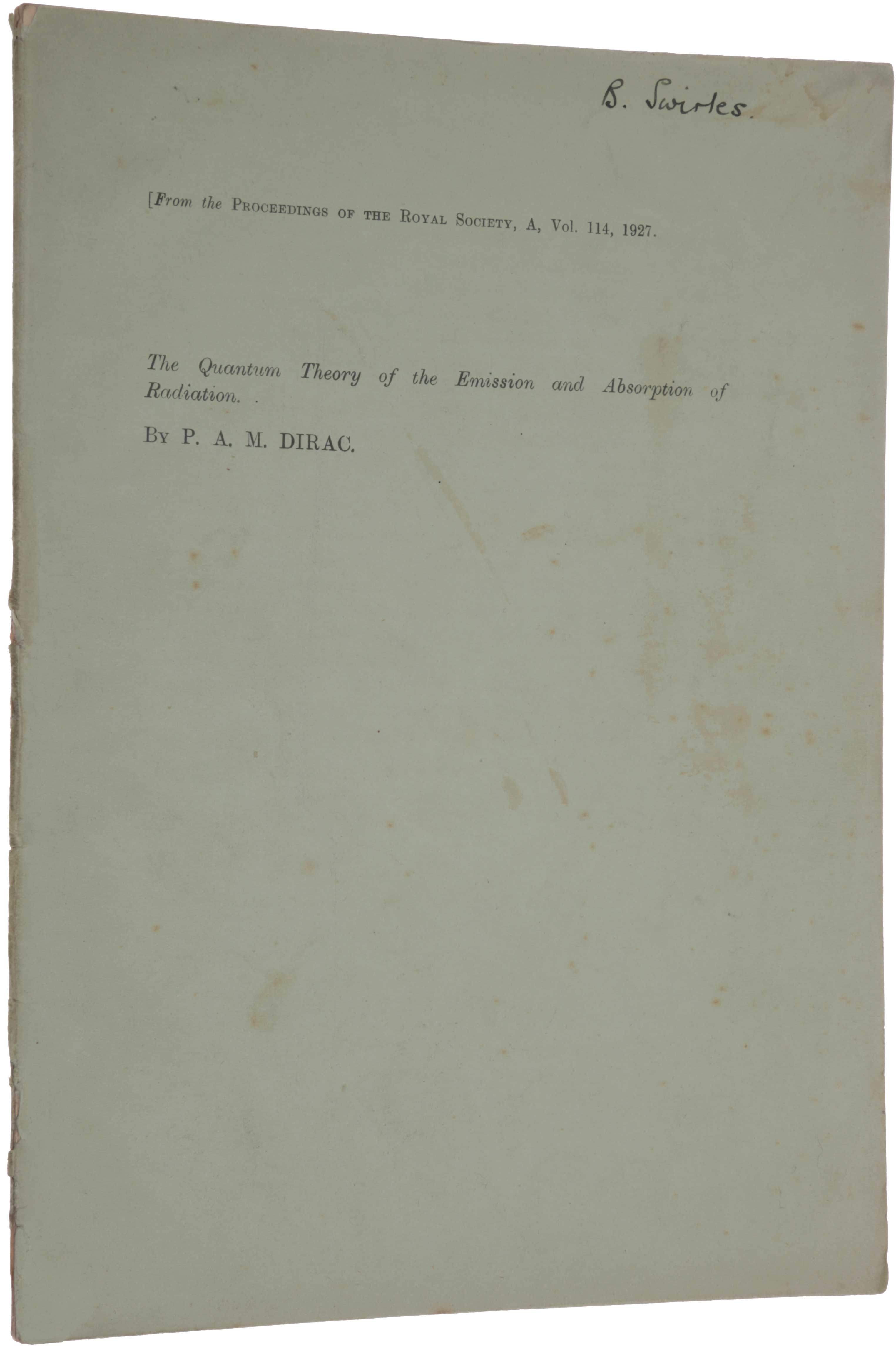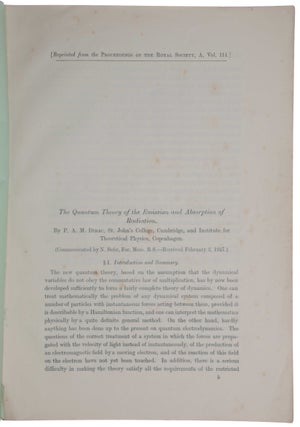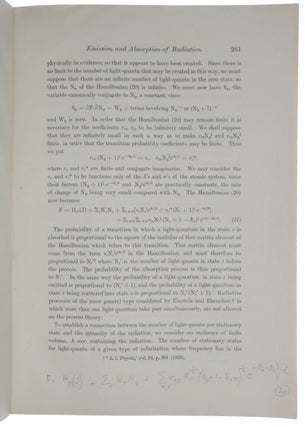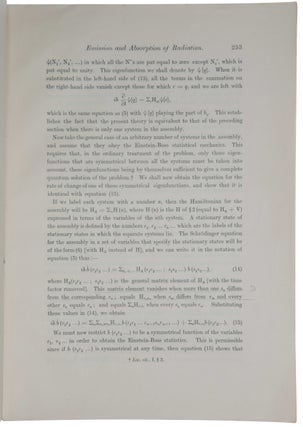The Quantum Theory of the Emission and Absorption of Radiation. Offprint from Proceedings of the Royal Society A, vol. 114, 1927.
[London: Harrison & Sons for the Royal Society, 1927]. First edition, extremely rare offprint, of Dirac’s quantum theory of the electromagnetic field, which for the first time reconciled the wave and particle nature of light. “This paper marks the birth of quantum electrodynamics. In his ‘Introduction and Summary,’ Dirac noted that the new quantum theory, based on non-commuting dynamical variables, was by then sufficiently developed to form a ‘fairly complete theory of any ‘dynamical system’ composed of a number of particles with instantaneous forces acting between them, provided it is describable by a Hamiltonian function.’ But hardly anything had been done ‘up to the present on quantum electrodynamics.’ ‘The questions of the correct treatment of a system in which the forces are propagated with the velocity of light instead of instantaneously, of the production of an electromagnetic field by a moving electron, and of the reaction of this field on the electron, have not yet been touched. In addition there is a serious difficulty in making the theory satisfy all the requirements or the restricted principle of relativity’ … Gregor Wentzel, who contributed significantly to the development of quantum electrodynamics during the 1920s, commented in 1959: ‘Today the novelty and boldness of Dirac’s approach to the radiation problem may be hard to appreciate … there had been no possibility within the correspondence principle framework to understand the process of spontaneous emission or the disappearance of a photon. Dirac’s explanation … came as a revelation’ … In his paper, Dirac dealt with the problem of an atom interacting with the radiation field in two distinct ways that can be characterized as the ‘corpuscular’ and the ‘wave’ approaches. In the corpuscular approach, the light quanta are described as an assembly of ‘non-interactive particles moving with the speed of light and satisfying the Einstein-Bose statistics’ … In the last brief section of his paper, Dirac turned to the interaction of an atom with the electromagnetic field as described from the wave point of view … In a lecture on the origin of quantum field theory in 1982, Dirac characterized the two approaches as follows: ‘Instead of working with a picture of the photons as particles one can use instead the components of the electromagnetic field. One thus gets a complete harmonizing of the wave and corpuscular theories of light. One can treat light as composed of electromagnetic waves, each wave to be treated like an oscillator; alternatively, one can treat light as composed of photons, the photons being bosons and each photon state corresponding to one of the oscillators of the electromagnetic field. One then has the reconciliation of the wave and corpuscular theories of light. They are just two mathematical descriptions of the same physical reality” (Schweber, pp. 23-31). “Dirac’s approach was instantly welcomed as the first consistent quantum theory of radiation and accepted as the paradigm in a whole series of subsequent studies” (Kojevnikov, p. 232). “Salam and Wigner, in their preface to the Festschrift that honored Dirac on his seventieth birthday and commemorated his contributions to quantum mechanics, succinctly assessed the man. ‘Dirac is one of the chief creators of quantum mechanics … Posterity will rate Dirac as one of the greatest physicists of all time … He is a legend in his own lifetime and rightly so’” (ibid., pp. 11-12). Not on OCLC, no copies in auction records. Provenance: Bertha Swirles (1903-99) (signature on front wrapper, marginal pencil annotations including an equation in the lower margin of p. 261). As an undergraduate at Cambridge Swirles attended lectures by J. J. Thomson and Rutherford. She remained at Cambridge in 1925 to undertake research in mathematical astronomy under the supervision of Ralph Fowler; another of Fowler’s research students, a couple of years ahead of Swirles, was Paul Dirac. After periods at Bristol, Imperial College, London, and Manchester, Swirles took up a lectureship in mathematics at Girton College, Cambridge in 1938, where she remained for the rest of her career. Before Dirac’s work, the understanding of the emission and absorption of radiation was founded on that set out by Einstein in 1917. Einstein admitted the existence of three kinds of processes involving the interaction of radiation with matter: spontaneous emission, absorption, and stimulated emission. Einstein denoted the probability per unit time of these processes A, ρB, and ρB’, where ρ is the intensity of the incident radiation in the cases of absorption and stimulated emission. Einstein showed that, in order to satisfy Planck’s radiation law, one must have B = B’, so that the processes were determined by two coefficients, A and B. The new process of stimulated emission, in which an atom is ‘persuaded’ to undergo a quantum jump between two quantum states when radiation of the correct frequency is incident upon it, is the process involved in the operation of the laser. Dirac’s first study of radiation theory was the subject of the last section of the important paper ‘On the Theory of Quantum Mechanics’. The first part of this paper is best known for establishing the connection between Bose-Einstein statistics and symmetric wave functions, on the one hand, and what became known as Fermi-Dirac statistics and anti-symmetric wave functions, on the other. In the second part of this paper, “Dirac considered a system of atoms subjected to an external perturbation that could vary arbitrarily with the time. Of course, the particular perturbation he had in mind was an incident electromagnetic field, but, characteristically, he stated the problem in the most general way possible … [Dirac obtained results] ‘in agreement with the ordinary Einstein theory,’ that is, with the quantum mechanical derivation of the B coefficients that occurred in Einstein's theory of 1917. Since he made use of a classical description of the electromagnetic field, Dirac was not at the time able to proceed further, and he noted, ‘One cannot take spontaneous emission [i.e. the A coefficients] into account without a more elaborate theory.’ This more elaborate theory was ready less than half a year later” (Kragh, pp. 120-121). “The introduction to the ‘Quantum Theory of Radiation’ appears to have been written after reflection on the already completed body of the paper. It presented the construction of a quantum theory ‘of the emission of radiation and of the reaction of the radiation field on the emitting system’ as the main object of the paper. This must be accomplished by taking the Hamiltonian for an atom interacting with an electromagnetic field and converting the classical field quantities into quantum-mechanical operators. If the Hamiltonians were then written in terms of a closed system, that is, with terms representing the energies of the atom, the field and the interaction, a calculation of the coefficient of spontaneous emission, as well as of induced emission and absorption, would be possible, and thus the problem that had been left open would be solved. Dirac also reported that he had discovered a way to write the Hamiltonian for matter and radiation in terms of the interaction of the atom with an assembly of light quanta. This gave him two equivalent expressions whose starting points were, respectively, waves and quanta. This equivalence, on the one hand, and the translation of the classical field variables into quantum operators, on the other, provided the formal basis for an understanding of the constitution of light” (Bromberg, p. 151). “According to Dirac’s recollections, the fundamental idea of his 1927 radiation theory was obtained unsystematically and unexpectedly. It was ‘one of those ideas out of the blue’ from which so much of his science originated. The work was the result of ‘playing about with [the Schrodinger equation] . . . [and] seeing what happens when you make the wave functions into a set of non-commuting variables.’ This idea out of the blue led to what was later called ‘second quantization.’ Instead of treating the energies and phases of radiation as c-numbers [i.e., commuting quantities], as he had done in his 1926 paper, Dirac treated them as q-numbers [non-commuting quantities, generalizing the matrices of Heisenberg’s quantum mechanics]. In general, second quantization involves considering the wave function as an operator instead of just a number … “In order to calculate the probabilities of absorption and emission of a photon, he constructed a Hamiltonian that described the interaction between a photon and an atom. The Hamiltonian had to incorporate the fact that photons are not conserved but may be spontaneously created or destroyed. Dirac included this feature in his Hamiltonian by introducing unobservable, or spurious, photons, that is, photons with zero energy and momentum: ‘When a light-quantum is absorbed it can be considered to jump into this zero state, and when one is emitted it can be considered to jump from the zero state to one in which it is physically in evidence, so that it appears to have been created. Since there is no limit to the number of light-quanta that may be created in this way, we must suppose that there are an infinite number of light-quanta in the zero-state.’ “Dirac introduced the idea of zero-state photons because he believed such entities were necessitated by formal reasons. From the point of view of methodology, it should be noted that unobservable, zero-state photons were dubious entities according to the positivist, Heisenberg-inspired view of physical theory that Dirac by and large accepted. This only illustrates that Dirac's positivism was not strict. Also worth noticing is that in 1930, when introducing the hole theory of electrons, Dirac proceeded in a way that was conceptually similar to the way he followed in formulating his radiation theory … “In the last section of his paper, Dirac turned to consider the interaction between an atom and radiation from the wave point of view. He again calculated the Einstein coefficients, getting the same result he had obtained when using the photon point of view. He concluded that ‘… the Hamiltonian which describes the interaction of the atom and the electromagnetic waves can be made identical with the Hamiltonian for the problem of the interaction of the atom with an assembly of particles moving with the velocity of light and satisfying the Einstein-Bose statistics, by a suitable choice of the interaction energy for the particles … There is thus a complete harmony between the wave and light-quantum descriptions of the interaction’” (Kragh, pp. 121-124) “The quantization of the electromagnetic field, as carried out in the construction of the second Hamiltonian for atoms and waves, by itself brought with it introduction of light quanta. ‘[The assumption] that the variables are q-numbers satisfying the standard quantum conditions immediately gives light-quantum properties to the radiation’” (Bromberg, p. 153). “As an indirect consequence of his theory, Dirac arrived at a completely new picture for the vacuum. After Einstein had abolished the concept of the ether, the matter-free and field-free vacuum was considered as an entirely empty space. But in quantum mechanics, because of Heisenberg’s uncertainty principle, the electromagnetic field oscillators cannot be strictly at rest. As a consequence, even in the ground state with the lowest possible energy, there still exist the so-called zero-point oscillations of quantum oscillators. Hence, the oscillatory nature of the electromagnetic field of radiation leads to the zero-point oscillations of this field in the vacuum state (the state of lowest possible energy). The physical vacuum is not an empty space but is ‘populated’ with zero point oscillations which are the cause of the spontaneous emission of radiation from atoms. Thus Dirac’s theory provided the explanation for all results regarding the emission and absorption of radiation by atoms” (Mehra & Milton, p. 180). “Everybody was impressed by the new radiation theory. Heisenberg and Pauli soon decided to construct their own quantum electrodynamics on the same basis. Bohr liked it too because it fit well with his philosophy of complementarity. ‘The renunciation of intuition in space and time that characterizes this treatment of the [radiation] problem gives and impressive indication of the essentially complementary nature of description in the theory of quanta’” (Darrigol, p. 226). “On the other hand, since the early 1930s [Dirac] was an active critic of the theory and tried to develop alternative schemes. He did not become satisfied with the later method of renormalization and regarded it as a mathematical trick rather than a fundamental solution, and died unreconciled with what, to a large extent, was his own brainchild” (Kojevnikov, p. 229). “Although not well known to the general public, Paul Adrian Maurice Dirac hardly needs to be introduced to physicists and historians of science. Born in Bristol in 1902 as a Swiss citizen – his father was Swiss and Paul only acquired British nationality in 1919 – he became one of the most important theoretical physicists ever. His impact on modern physics may even have been greater than that of Einstein. Young Dirac made his first breakthrough in the fall of 1925 when he developed his own version of quantum mechanics known as q-number algebra, and over the next few years he established himself as a leading expert in the new quantum physics. In 1927-28 he made pioneering contributions to quantum statistics (Fermi-Dirac statistics), quantum electrodynamics, and relativistic quantum theory. The linear and relativistically-invariant wave equation for the electron that he published in early 1928 not only explained the electron’s spin and magnetic moment, but also, three years later, led to the prediction of antielectrons (positrons) and antiparticles more generally. “Dirac’s genius was recognized early on. For example, he was part of the exclusive company of physicists invited to the famous Solvay conference in 1927. In 1930, at the unusually young age of 27, he was elected a fellow of the prestigious Royal Society, and the same year he published his monumental Principles of Quantum Mechanics. Two years later he was appointed Lucasian Professor of mathematics at Cambridge University, the chair once held by Isaac Newton and later by Stephen Hawking. Another high point of Dirac’s career came in 1933, when he was awarded the Nobel Prize in physics, sharing it with Erwin Schrödinger. Although Dirac’s scientific fame is closely linked to his fundamental contributions to quantum theory, and especially to those of the period 1925-34, he also dealt with other subjects, including cosmology, classical electron theory, and the general theory of relativity. Moreover, the influence of his ideas extended beyond physics, especially to mathematics (e.g. the Dirac δ-function, Dirac matrices, and Dirac operators). Paul Dirac remained Lucasian Professor until his retirement in 1969, when he joined the physics department of Florida State University in Tallahassee. He died in 1984, and in 1995 a commemorative stone carrying his name and equation was unveiled at a ceremony in Westminster Abbey. Bromberg, ‘Dirac’s Quantum Electrodynamics and the Wave-Particle Equivalence,’ pp. 147-157 in: History of Twentieth Century Physics. Proceedings of the International School of Physics, ‘Enrico Fermi’, Course LVII (Weiner, ed.), 1977. Darrigol, ‘The Origin of Quantized Matter Waves,’ pp. 197-253 in: Historical Studies in the Physical and Biological Sciences 16 (1986). Kojevnikov, ‘Dirac’s quantum electrodynamics,’ pp. 229-259 in: Einstein Studies in Russia. Einstein Studies, Vol. 10, 2002. Kragh, Dirac. A Scientific Biography, 1990. Mehra & Milton, Climbing the Mountain. The Scientific Biography of Julian Schwinger, 2003. Schweber, QED and the Men Who Made It, 1994.
8vo (254 x 179 mm), pp. [243], 244-265, [1, blank] Original printed wrappers.
Item #5979
Price: $25,000.00








